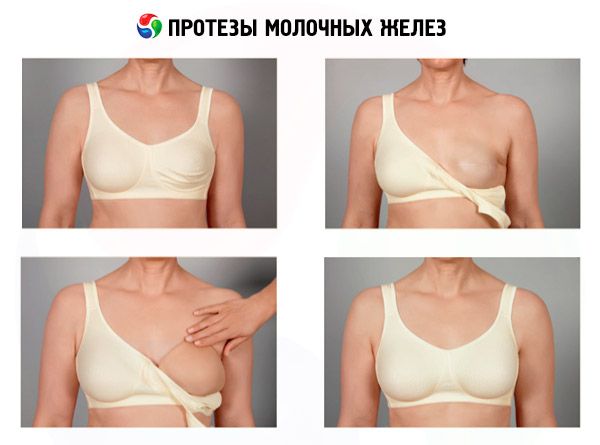Medical expert of the article
New publications
Breast prostheses
Last reviewed: 06.07.2025

All iLive content is medically reviewed or fact checked to ensure as much factual accuracy as possible.
We have strict sourcing guidelines and only link to reputable media sites, academic research institutions and, whenever possible, medically peer reviewed studies. Note that the numbers in parentheses ([1], [2], etc.) are clickable links to these studies.
If you feel that any of our content is inaccurate, out-of-date, or otherwise questionable, please select it and press Ctrl + Enter.
Surgical treatment of malignant tumors of the mammary glands is often performed by mastectomy - an operation during which the mammary gland is completely removed. In this case, it is necessary to hide the resulting external defect - the absence of one or both breasts in women. For this purpose, mammary gland prostheses are used.
What types of breast prostheses are there?
If reconstruction of the removed mammary gland is possible, then a permanent silicone internal prosthesis (endoprosthesis) can be installed under the skin or muscle tissue in place of the missing gland. But this is the field of plastic surgery, and such operations cannot be performed on all patients who have lost their breasts (and their cost is quite high).
The most commonly used reasonable alternative is removable breast prostheses (exoprostheses), which quite realistically create the external appearance of having breasts.
A silicone breast prosthesis imitates the gland with the help of medical silicone gel placed in a durable polyurethane shell, which can be oval, round, teardrop-shaped, heart-shaped or triangular. Moreover, such a breast prosthesis is quite dense to the touch and at the same time mobile, after putting it on it quickly warms up to body temperature (which creates a more comfortable feeling). By its weight, the prosthesis compensates for the missing gland, which, according to doctors, contributes to an even load on the shoulders and spine and prevents the occurrence of muscle strain and poor posture.

Breast prostheses can be symmetrical, asymmetrical and sectoral. The need for an asymmetrical prosthesis arises in the case of radical removal of one breast, affecting the chest tissue and the armpit area. And in the case of removal of part of the organ (sectoral resection), the removed part of the breast can be replenished with a sectoral prosthesis, which is an overlay made of silicone.
It should be borne in mind that in the first two to three months after surgery, a primary or lightweight breast prosthesis is needed, which is made of textiles filled with lightweight fibrous materials. In addition, such prostheses are recommended if the breast size is large and when mastectomy is accompanied by lymph congestion and edema.
The size of breast forms can be correctly determined by measuring the circumference of the chest under the mammary glands and the circumference of the chest at the level of the nipples. The first result is the bra size you need, and the size of its cup and the form itself is: the circumference of the chest at the level of the nipples minus the circumference of the chest under the mammary glands. If this difference is 10-12 cm, then the size (size) of the form will be designated AA; 12-14 cm - A; 14-16 cm - B; 16-18 cm - C; 18-20 cm - D; 20-22 cm - E; 22-24 cm - F; 24-26 cm - G; 26-28 cm - H. The last two sizes (G and H) are not produced by all manufacturers, and some designate size E as DD, and size F as DDD.
Lingerie for breast prostheses
How to wear breast prostheses? Special underwear for breast prostheses is produced for fixing and wearing exoprostheses.
The main thing is to choose a bra for a breast prosthesis correctly: so that it does not move under the breast and on the back, but fits tightly around the chest, but in no case squeezes it (leaving red marks on the skin). It is better to choose bra models with wide straps. And the correct determination of the required size has already been discussed above.
The difference between orthopedic bras and regular ones is the presence of “pockets” in which the silicone breast imitator will fit, and denser side panels of the bra.
Manufacturers produce all sizes of breast prosthesis bras in various styles and colors, but they all cover the breasts completely (including the "low neckline" area). First of all, it is important that such a bra holds the breast imitators in place and supports them in a natural position.
The corresponding shops and salons also sell bathing suits (bikinis and one-pieces) for women who are forced to wear breast prostheses.
The denture must be washed periodically, and it is best to use the toilet soap that you use yourself (no more active detergents should be used). You also do not need to rub, squeeze or shake the dentures: it is enough to wipe them with a towel. And for storing the denture taken off before going to bed, use the packaging in which the denture was purchased, or another suitable clean container.
Where can I buy breast prostheses?
Breast prostheses from various manufacturers, as well as lingerie for breast prostheses, can be found in orthopedic salons and stores, which are located in all regional centers and many large cities of Ukraine. In any case, this is how Anita care prostheses (Anita Dr. Helbig GmbH, Germany) and bras from the same company are sold.
Oncology mammology specialists can also recommend breast prostheses from the following manufacturers:
- Pofam-Poznan (Poland) – Maxima prostheses;
- Amoena (Germany) - Amoena prostheses;
- Thuasne Deutschland GmbH (Germany) – Silima exoprostheses;
- Ottobock GmbH (Germany) – Comfort Contura breast prostheses.
In several cities there are representative offices of the Kyiv ONPRTS Ortes and the Kharkov enterprise Ortopomoshch, where you can go to purchase mammary gland prostheses from a domestic manufacturer.


 [
[